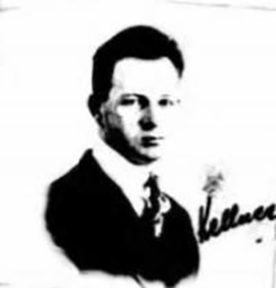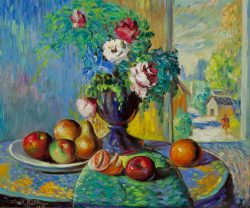Charles Kellner, from a photograph from U.S.passport application, dated 1920 (www.ancestry.com).

Charles H. Kellner 1890–1979
Born in Kasa, Czechoslovakia (now Košice, Slovakia), Charles Harry Kellner immigrated to New York as a teenager in 1907. Working factory jobs, he studied art at night. After four years in New York he moved to Chicago, where he attended the Chicago Academy of Fine Arts (founded in 1902), studying under Wellington Reynolds and Victor Higgins, and then at the Art Institute of Chicago’s school. Kellner had begun working as a commercial artist when the U.S. entered World War I. He became a naturalized citizen and enlisted in the American Expeditionary Forces. Following the war, Kellner studied in the American Art Schools in the occupied German city of Koblenz and in Paris, where he won prizes for both portraiture and landscape painting. He then spent two years studying with Pierre Bonnard and Harry Lachman in Paris and in Rome. Kellner traveled widely in Western Europe and the British Isles and he painted landscapes in Normandy.
Back in Chicago, Kellner realized a modest success in the 1920s as a painter of sympathetic portraits. He received many of his commissions from within the local Jewish community; others resulted from the artist’s ties to the musical world through his wife, Ida, a concert pianist. Kellner also painted pastoral landscapes and still lifes. He exhibited his paintings in regular group exhibitions at the Palette and Chisel Club, the All-Illinois Society of the Fine Arts, and the Illinois Academy of Fine Arts. He was represented in just one annual salon at the Art Institute, the 1931 “Chicago and Vicinity” show. One of his portraits was featured in the Illinois artists’ exhibition at the Century of Progress Exposition in 1933, and he contributed murals to the Illinois Building in the 1939 New York World’s Fair, possibly under the auspices of the WPA. Kellner also participated in the art exhibitions held at Navy Pier between 1937 and 1940. Beginning in 1929 and continuing through the 1950s, he showed paintings, often on religious themes, in various Chicago exhibitions for Jewish artists, including those organized by the Jewish Women’s Art Club, the group Around the Palette, and its successor, the American Jewish Art (later Arts) Club. Kellner continued to paint into his later decades, producing exuberantly colored landscape and still-life images.
Wendy Greenhouse, PhD
